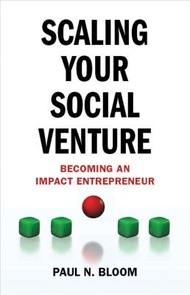
Many corporations are obsessed with scale. It brings efficiencies and effectiveness that small- to mid-sized businesses can’t provide. Only a few social ventures — such as Habitat for Humanity, Teach for America, and Mothers Against Drunk Drivers — have scaled. But scaling is becoming a mantra for some of those concerned about solving the world’s problems in a resource-constrained environment.
The concept is that more social good could be done if effective organizations scaled. In his book Scaling Your Social Venture: Becoming an Impact Entrepreneur, Paul N. Bloom from Duke University’s Center for Advancement of Social Entrepreneurship provides a roadmap for social ventures that want to scale.
Which organizations should consider scaling social impact? They are non-profits, for-profits, hybrids, and government organizations that share one thing in common: They all employ innovative approaches to addressing social problems.
Bloom has identified seven essential factors to success, which he calls SCALERS: staffing, communicating, alliance-building, lobbying, earnings-generation, replicating, and stimulating market forces. While you don’t need to be good at all seven, you do need to be good at most of them.
Bloom provides a framework and a variety of self assessment tools to help leaders of social ventures think through whether scaling is right for their organizations. Questions they need to ask themselves include:
- Are you ready to scale?
- How should you scale?
- What will it take to be successful?
Scaling is not for everyone. Just as there is a need for boutiques as well as big box retailers, some excellent social ventures operate best as small- or mid-sized organizations.
Those who choose to scale will face hurdles that must be leapt over, gotten around or just knocked over. It takes discipline, hard work, and creativity to be successful. The journey is not linear. And there is no one right solution for everyone. Many decisions must be made along the way by the senior management team and the board.
This is not a path for the faint-hearted.
Scaling organizations need to think through the effects, outcomes, and impacts that they want to achieve as a result of what they do. Measuring and proving effectiveness is key, especially if you expect to raise money from government agencies, foundations, donors or investors. They’ll want to know your Theory of Change (i.e., logic model).
In addition to the book, another resource on scaling for social ventures is the Social Impact Exchange, in which both Bloom and I are involved. The Exchange’s goal is to build the field of scaling and develop an efficient capital marketplace that provides reliable funding for scaling high-impact non-profit initiatives. Membership is free. Duke University-Center for Strategic Philanthropy and Civil Society (CSPCS) and its Center for the Advancement of Social Entrepreneurship (CASE) are supporting the development of the Exchange.
The Exchange will launch its fourth business plan competition for non-profits early this fall. If you make it to the second round, you might get me as your coach. In the meantime, here’s some guidance on writing a winning business plan for the competition or to plan your growth.
Follow Geri Stengel on Twitter: www.twitter.com/ventureneer